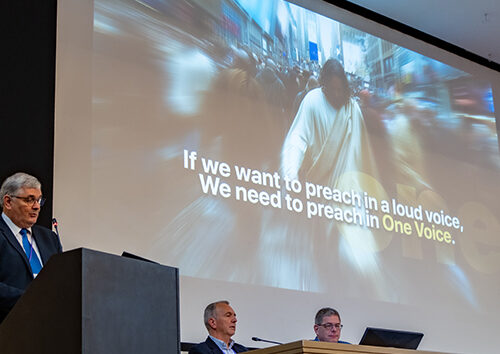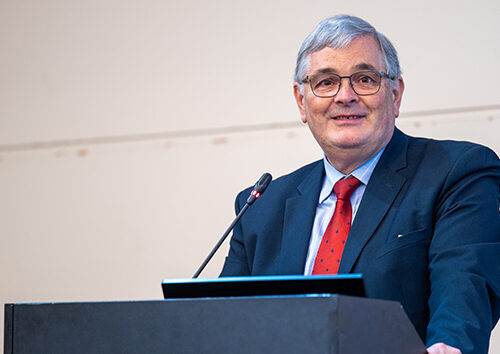17 May 2022 | Bracknell, England [Dr Laszlo Gallusz]
On Sunday 15 May, Dr Laszlo Gallusz was invited to share a devotional thought with Newbold College of Higher Education board members, a summary is reproduced below.
The church fathers have compared the Gospel of John to an eagle. The reason for this comparison is the eagle’s sharpness of sight – and for which reason eagles are considered the kings of birds.

Biologists tell us that the proportion of the eagle’s brain devoted to sight is seven times greater than that in humans. It is no wonder eagles can focus in on a mouse in the bush from a great height!
Like an eagle, the Gospel of John is one of the sharpest biblical books in terms of theological thought. It speaks with a special depth about God, about Jesus, about the world and its people. It speaks about faith, about the present and future, and about the role of discipleship in the church and in the world.
The Significance of the Prologue
If we want to understand this high-flying perspective, we need to give careful attention to the beginning of the Gospel, the Prologue. The Prologue comprises the first 18 verses of the Gospel and it is one of the most brilliant texts ever written in human history. Martin Hengel, a well-known German scholar says that the prologue provides, “A magnificent gate into the fourth Gospel.”
If we read the Gospel in its cultural and historical context, we will discover that in the ancient Graeco-Roman literature, prologues were very important. The key information for understanding a play (whether tragedy or comedy) was often stated in the prologue. This is also true of the fourth Gospel: they key concepts, key ideas and key words appear first in the Prologue and are later developed in the body of the book. In short, if we do not understand the prologue, we will miss some of the key ideas.
The Analysis of the Climactic Statement
How the prologue ends is super important! The last verse is the cream on the top of cake – it is the climactic statement of the prologue. “No one has ever seen God. It is God the only Son, who is close to the Father’s heart, who has made him known” (1:18 NRSVA).
There is an important contrast in this text. It says that: (1) no one has ever seen God, but, at the same time, it claims that (2) seeing God is made possible from now onward! It is made possible through Jesus who has made him known. The four last words in the English translation ‘has made him known’ are one word in the Greek text. One word, which is the last word: the strawberry on the top of the cream, on the top of the cake.
Which Greek word is that? ‘exēgēsato’ – the aorist form of the verb ‘exēgeomai’ which means “to describe in great detail,” to “explain profoundly”. From this verb we have the term exegesis: an approach to the Scripture which seeks to penetrate to the depth of the text, bringing out the treasure which is found in it.
In one loaded term John defines why the Word became flesh and why he lived among us: his goal was to make an exegesis of the Father to us. No one has ever seen Him, no one ever penetrated His being, but Jesus did an exegesis of God himself for us. The content of this ‘exegesis’, of this revelation, is expounded in the Gospel of John.
The final word in the prologue is not about the content, but about the Revealer Himself, about the Exegete: Jesus. The focus is on the Word who is himself the original, primary, and authentic revelation. What John states is: the revelation of God has arrived in the person of Jesus. Jesus made an exegesis of Father for us. He became the ultimate expression of the grace of God.
So What?
And the question remains – so what? The Newbold Board today will discuss matters related to ministerial training and theological education. This cannot be reduced simply to learning of theological propositions, dry information on biblical languages or techniques and models in pastoral theology. Solomon says, “The teaching of the wise is a fountain of life, so that one may avoid the snares of death” (Proverbs 13:14 NRSV, emphasis added). This is a very important statement about the nature of teaching needed in our institutions.
 It is not enough to do text exegesis, to interpret ideas, to discuss concepts or to learn how to make administrative structures work well -though these are all critically important skills to develop at an educational institution. The exegesis of Father needs to be done – for without it, the teaching cannot be a fountain of life.
It is not enough to do text exegesis, to interpret ideas, to discuss concepts or to learn how to make administrative structures work well -though these are all critically important skills to develop at an educational institution. The exegesis of Father needs to be done – for without it, the teaching cannot be a fountain of life.
This what Adventist education stands for – a wholistic approach. Adventist Education means nurturing the students’ minds, developing their intellectual capacities, but also nurturing their commitment to God and to the cause of the Gospel.
Dr Laszlo Gallusz serves as a Senior Lecturer in New Testament Studies at Newbold College of Higher Education.




